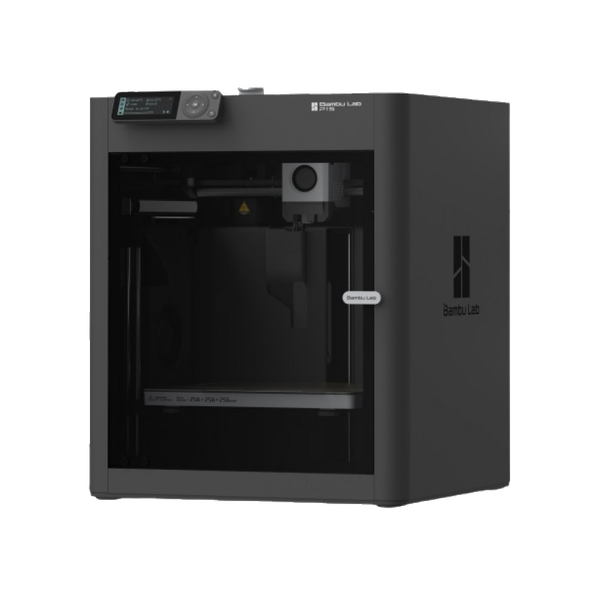If you make a purchase using a shopping link on our site, we may earn a commission. Learn More
Comparing the Bambu Lab P1S and Bambu Lab A1 Mini

Bambu Lab P1S
(~10.25 x 10.25 x 10.25 in)
Vs.

Bambu Lab A1 Mini
(~7.25 x 7.25 x 7.25 in)
About the Bambu Lab P1S
The Bambu Lab P1S is an upgraded version of the Bambu Lab P1P, adding an integrated enclosure with a see-through glass door, along with an air filter and additional fans to aid in part cooling and build chamber temperature management. These features allow the P1S to more effectively print temperature-sensitive filament types such as ABS and ASA. The P1S offers high-speed 3D printing in a robust CoreXY design with a print volume of 256 x 256 x 256 mm (10" x 10" x 10"). It includes a direct drive extruder with an all-metal hot end capable of heating up to 300°C, enabling it to use all 3D printing filament types including PLA, PETG, TPU, ABS, ASA, and more. The P1S includes firmware features such as vibration compensation and pressure advance to maintain print quality at speeds of up to 500 mm/s. Although it lacks the Lidar sensor and AI camera features of the Bambu Lab X1-Carbon, the P1S does include an automatic bed leveling system as well as an integrated camera for monitoring prints. The display on the P1S is a monochrome text-only display with a button controller, which is unusually limited for its price point. However, it also includes WiFi and can be controlled using the Bambu Studio computer application or Bambu Handy smartphone app, giving users the ability to monitor and control the printer remotely. Files can be loaded over WiFi or using a microSD card. The downside to the P1S is that repair parts are only available from the manufacturer, meaning you will need to trust Bambu Lab to continue to support the hardware and software of the P1S over the lifetime of the machine. Fortunately, Bambu Lab does offer a wide selection of repair parts on their site. Our overall take on the Bambu Lab P1S is that it's a compelling choice for users who want a capable 3D printer that doesn't require assembly or extensive calibration. In many ways, this is the same printer as the popular Bambu Lab P1P, but with the added enclosure and air filter. Those features aren't critical for 3D printing, but give the P1S added capability to print more materials as well as reducing noise and smell during printing. We've seen many users upgrade the P1P with an enclosure, so it's likely worth it to pay the added price for the P1S. However, the P1S is limited in a few ways--it doesn't have as many ease-of-use features as the X1-Carbon, and its proprietary hardware and firmare mean you are reliant on Bambu Lab for continued support of the machine. For users who want a 3D printer that feels high-end but want to stay within a budget, the Bambu Lab P1S is an excellent choice.
About the Bambu Lab A1 Mini
The Bambu Lab A1 Mini is an entry-level 3D printer with advanced sensors and printing features that are typically only found on machines in higher price tiers. Its build volume of 180 x 180 x 180 mm (7.1" x 7.1" x 7.1") is smaller than average, and the single Z column design doesn't offer the same physical stability of the standard 2-column or enclosed frame designs found on many other printers. However, the calibration and monitoring features of the A1 Mini may make up for these shortcomings. The A1 Mini includes a direct drive extruder with an all-metal hot end that can heat up to 300°C, allowing it to print most standard filament types, including flexible filament. However, the PEI build plate can only heat up to 80°C, which will limit the printer's ability to print certain materials such as ABS. The Bambu Lab A1 Mini includes advanced firmware features such as vibration compensation and pressure advance, improving print quality. The A1 Mini also includes automatic bed leveling and Z offset calibration to simplify the calibration process. A new flow rate sensor in the hot end allows it to calibrate the flow rate of the filament to further improve printing performance. Similar to other Bambu Lab printers, the A1 Mini includes WiFi connectivity, allowing users to monitor and control the printer with the Bambu Studio computer application or the Bambu Handy smartphone app. A camera mounted in the Z gantry allows for remote monitoring of prints. Our take on the Bambu Lab A1 Mini is that its unconventional design and small build volume may be hard for some users to accept, but the advanced printing features make it worth considering as an entry-level machine. The A1 Mini is more expensive than other entry-level 3D printers, and can't print items as large as some of those machines, but its sensors and firmware features should make it capable of producing higher-quality prints.
Click here to view the Bambu Lab P1S on the Bambu Lab website.
Click here to view the Bambu Lab A1 Mini on the Bambu Lab website.
You can find a side-by-side comparison of the specifications for these two printers in the table below:
Details & Specifications
Bambu Lab P1S
Bambu Lab A1 Mini
General
Extruder & Hot-end
Physical Characteristics
Usability
Electronics
Where to Buy
Brand Overview
Bambu Lab
Bambu Lab, based in Shenzhen, China, and founded by five ex-DJI engineers, has made notable strides in the 3D printing arena with their unique combination of innovation and user-friendly interfaces. They launched their journey with a successful Kickstarter campaign in 2022, securing over $7 million in funding. Their printer lineup, from the flagship Bambu X1-Carbon to the more affordable Bambu P1P, showcases their commitment to high-performance features while ensuring ease of use, making them a rising competitor in the 3D printing industry.